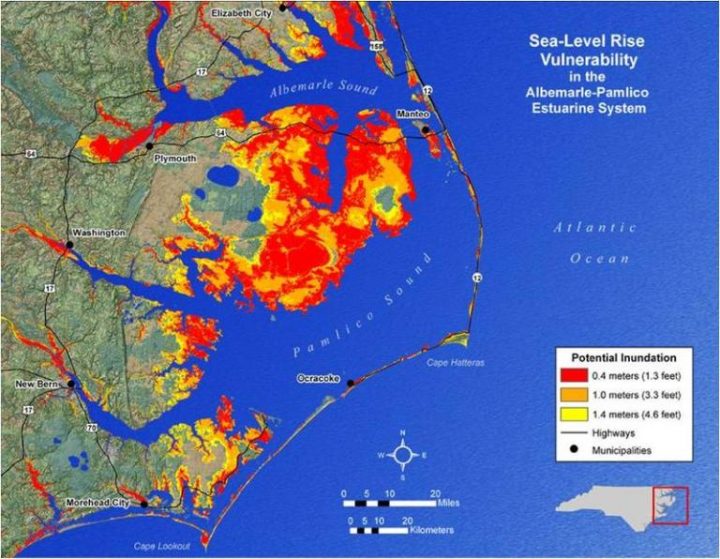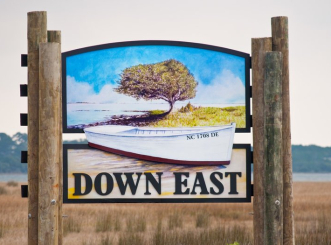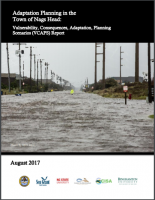
The following first appeared in Frank Tursi’s blog, the White Oak Journal.
SWANSBORO — The numbers aren’t pretty. They paint a bleak picture of a drowning people.
Supporter Spotlight

In less than 12 years, 6,500 houses along the North Carolina coast worth more than a $1 billion today could be flooded every other week by normal high tides. By 2060, the rising Atlantic will make dozens of coastal communities nearly uninhabitable. At least 120,000 coastal North Carolinians could be climate refugees by the end of the century.
Like I said, grim stuff.
The Union of Concerned Scientists issued a report several weeks ago that could be the script of a dystopian movie. It analyzed for the first time by ZIP code the effects rising seas could have on the country’s coastal communities at five points in time – 2030, 2045, 2060, 2080 and 2100. It looked at the number of existing homes that will be flooded by normal high tides as the climate continues to warm, the values of those houses and the property taxes at risk. It counted the people who could be displaced.
The scientists mean to scare you. They hope their report will then lead you to cry for a life preserver while there’s still time.
Smart people, like those who compiled this report, have been warning us for years about accelerated sea level rise triggered by a warming climate and what it will do to buildings perched at the water’s edge, especially on a uniformly flat landscape like the North Carolina coast. After Gold Coast of South Florida and the bayous of Louisiana, we may be living on the most-threatened coastline in the country.
Supporter Spotlight
There are several interactive, online maps that graphically display the rising water in creeping colors of red and purple. But assigning those dangers to a familiar number seems to strike closer to home. 28584, for instance. That’s Swansboro’s ZIP code. That’s me and my neighbors. To think that 60 houses, representing more than $20 million in current value, in the little place I call home could be regularly flooded by 2030 makes this downright scary. About 1,100 people, or almost 10 percent of the current population of our ZIP code, will be flooded out of their homes by 2100. As bad as that sounds, they’ll be in far, far better shape than many of their coastal neighbors.
First, Some Qualifiers
There are some important things to keep in mind before we go any further with this. The authors of the study assume that future flooding will reach a threshold where normal routines become impossible and coastal residents, communities and businesses are forced to make difficult, often costly, choices. They call this level of disruption “chronic inundation,” which they define as flooding that occurs 26 times a year, or about once every other week. It is important to note that this flooding is not caused by storms—it is simply the result of high tides inching higher and reaching farther inland as sea levels rise.
The report also doesn’t attempt to predict future coastal development or population growth. All projections are based on current population and housing stocks. So, if anything, the numbers get more conservative as the predictions progress farther into the future.
Neither did the authors factor in sea walls, moving or raising houses or other measures that may be taken in the future to lessen the damage.
And, finally, they use the most-dire scenario. They assume that global sea level rise will average about 7 feet worldwide by 2100. That’s currently at the far end of predictions and would result if we do little to control emissions. That may sound extreme but keep in mind that sea rise projections are forever edging upwards as the climate continues to warm and glaciers in Greenland and Antarctica continue to melt and we continue to do nothing meaningful. The current scientific consensus of 3 feet by 2100 was considered extreme a decade ago. A decade hence, 7 feet may seem like a fond wish.
Not Just Beach Towns
If they consider the issue of rising seas at all, most people naturally think about the beach. Nags Head and Wrightsville Beach and Ocean Isle and places like that are most endangered. The report’s numbers, though, reveal a far different reality that reflects our coast’s geography and flat topography. Much of the initial flooding occurs inland, away from the oceanfront and along the vast labyrinth of sounds, rivers and creeks. Only later are beach towns affected.

Stumpy Point, for instance, is a good 20 miles from the ocean as that crow flies. The small, unincorporated community off U.S. 264 in Dare County instead backs up to Pamlico Sound. About a third of the houses there could flood twice a month in just 12 years. Stumpy Point has, according to the study, the highest percentage of at-risk houses in the state in 2030.
Other inland communities aren’t far behind: Manns Harbor on Croatan Sound in Dare; Maple and its neighbor Barco along Coinjock Bay in Currituck County; Englehard in Hyde County; and Lowland and Hobucken in Pamlico County.
Chronic flooding becomes more widespread by 2060. It could threaten more than 30,000 existing homes along the North Carolina coast with a current value of about $7 billion. More than 40,000 people currently live in those houses. That’s more than the population of New Bern.
The low-lying lands from eastern Carteret County, up the Albemarle-Pamlico peninsula, to the Great Dismal Swamp on the Virginia border could be particularly hard hit. High tides in 2060 could threaten more than half the homes in Davis and Marshallberg in Down East Carteret. In Hyde and Tyrrell counties, 30 percent of existing homes could be regularly flooded. High tides could now reach more than a quarter of the houses in northern Currituck County bordering the swamp.
The beginning of the disintegration of the Outer Banks clearly shows up in the 2060 numbers. Almost half the houses in Frisco, Waves, Hatteras and Salvo on Hatteras Island could be subject to frequent high-tide flooding. While the effects are more limited on the higher, northern Outer Banks beaches, residential real-estate worth about $11 billion today could frequently be flooded in Nags Head, Kitty Hawk and Kill Devil Hills.
By 2100, the destruction of the southern Outer Banks is complete. High tides could flood more than half the homes in most of the beach towns. Flooding could hit 70 percent of the houses in Rodanthe and Salvo and 85 percent in Waves. Every current resident of Avon, Frisco and Hatteras would be displaced by high tides.
Three-quarters of the current population of Hyde County would also be refugees. The old, quaint fishing villages of Down East – Davis and Marshallberg, Williston and Gloucester, Smyrna and Sea Level – could become drowned ghost towns.
The coast’s major cities could also be devastated. Property currently worth $15 billion could be inundated in Wilmington. About 7,000 people in New Bern, or about a quarter its current population, could be flooded out of their homes. Almost half the current population of Elizabeth City could become refugees.
Are you sufficiently alarmed yet? Good. That’s what the report’s authors intended.
Now What?
Now, they would want you to think about where we go from here.
Certainly, putting a lid on emissions is still at the top of the to-do list, but that requires national and international actions and nothing meaningful has been done so far. We can all agree at this point that the Trump administration won’t do anything in the near term. In fact, its energy policies, if actually carried, out would make things worse.

Also at the top of the list are things we can all do individually to be smarter energy consumers and to reduce our carbon footprints. Frankly, such reductions would be small, incremental and largely meaningless. There’s absolutely nothing you and I can do personally at this point that will prevent our descendants from being flooded out of their homes.
We can, however, prepare for the future they face. The state Division of Coastal Management has begun to take the first steps to help communities plan for the more watery future. Its teamed up with experts at North Carolina State University and the Nature Conservancy to offer willing communities an opportunity to identify flood-prone areas and critical public and private infrastructure that are subject to flooding and storm damage and need to be protected. Communities can then use that information to devise protective local ordinances.
Swansboro is one of about 10 communities on the coast that have volunteered for the adaptation plan. The process just started and will probably take the rest of the year. A public meeting is planned in late August to get residents’ input. Follow this blog for more information.
It’s a good first step that every coastal community should be required to take it. The more prepared they are, the less it will cost all future taxpayers to bail them out – pun intended.
But that will take money and laws. The scope of the problem is too large for the small budgets of small communities, like Swansboro, to tackle. It will overwhelm even the largest cities. This is a problem that the state needs to tackle. That is a problem for the North Carolina General Assembly.
The subject of climate change has in the past received a frosty reception in the halls of the Legislative Building. Beholden to special interest groups, legislators a few years ago even attempted to ban planning for future sea level rise and were ridiculed worldwide for their efforts.
Now, they must step up. If they won’t, voters must replace them with people who will.
Your grandchildren’s and great-grandchildren’s futures depend on it. As the water rises around their ankles, they will wonder about our obstinacy and blindness. We should give them evidence that we haven’t totally lost our minds.







